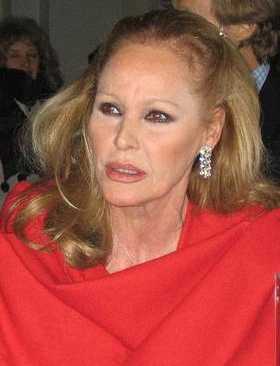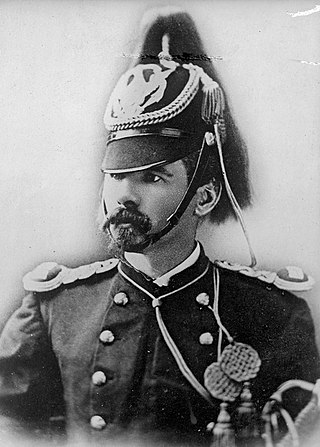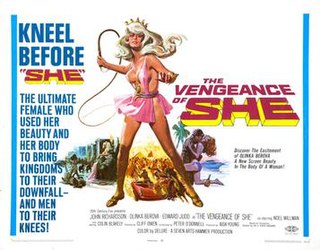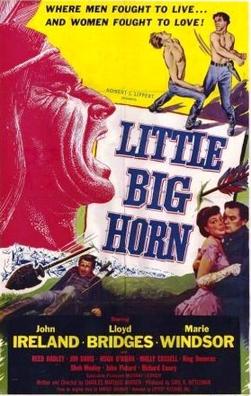
The Battle of the Little Bighorn, known to the Lakota and other Plains Indians as the Battle of the Greasy Grass, and commonly referred to as Custer's Last Stand, was an armed engagement between combined forces of the Lakota Sioux, Northern Cheyenne, and Arapaho tribes and the 7th Cavalry Regiment of the United States Army. The battle, which resulted in the defeat of U.S. forces, was the most significant action of the Great Sioux War of 1876. It took place on June 25–26, 1876, along the Little Bighorn River in the Crow Indian Reservation in southeastern Montana Territory.

George Armstrong Custer was a United States Army officer and cavalry commander in the American Civil War and the American Indian Wars.

Ursula Andress is a Swiss actress and former model who has appeared in American, British and Italian films. Her breakthrough role was as Bond girl Honey Ryder in the first James Bond film, Dr. No (1962). She later starred as Vesper Lynd in the 1967 Bond parody Casino Royale. Other credits include Fun in Acapulco (1963), 4 for Texas (1963), She (1965), The 10th Victim (1965), The Blue Max (1966), The Southern Star (1969), Perfect Friday (1970), Red Sun (1971), The Sensuous Nurse (1975), Slave of the Cannibal God (1978), The Fifth Musketeer (1979), Clash of the Titans (1981), and Peter the Great (1986).

The 7th Cavalry Regiment is a United States Army cavalry regiment formed in 1866. Its official nickname is "Garryowen", after the Irish air "Garryowen" that was adopted as its march tune. The regiment participated in some of the largest battles of the Indian Wars, including its famous defeat at the Battle of Little Bighorn, where its commander Lieutenant Colonel George A. Custer was killed.

The Battle of the Washita River occurred on November 27, 1868, when Lt. Col. George Armstrong Custer's 7th U.S. Cavalry attacked Black Kettle's Southern Cheyenne camp on the Washita River.

Richard Jaeckel was an American actor of film and television. Jaeckel became a well-known character actor in his career, which spanned six decades. He received an Academy Award nomination for Best Supporting Actor with his role in the 1971 adaptation of Ken Kesey's Sometimes a Great Notion.

Thomas Ward Custer was a United States Army officer and two-time recipient of the Medal of Honor for bravery during the American Civil War. A younger brother of George Armstrong Custer, he served as his aide at the Battle of Little Bighorn against the Lakota and Cheyenne in the Montana Territory. The two of them, along with their younger brother, Boston Custer, were killed in the overwhelming defeat of United States forces.

John Derek was an American actor, filmmaker and photographer. He appeared in such films as Knock on Any Door, All the King's Men, Rogues of Sherwood Forest (1950), and The Ten Commandments (1956). He was also known for launching the career of his fourth wife, Bo Derek.

Honeychile Rider is a fictional character in Ian Fleming's James Bond novel Dr. No. In the 1962 Bond film of the same name, her name was shortened and spelled Honey Ryder. In the film, she is played by Swiss actress Ursula Andress, with her lines dubbed by Nikki van der Zyl due to Andress' heavy accent.

Myles Walter Keogh was an Irish soldier. He served in the armies of the Papal States during the war for Italian unification in 1860, and was recruited into the Union Army during the American Civil War, serving as a cavalry officer, particularly under Brig. Gen. John Buford during the Gettysburg Campaign and the three-day Battle of Gettysburg. After the war, Keogh remained in the regular United States Army as commander of I Troop of the 7th Cavalry Regiment under George Armstrong Custer during the Indian Wars, until he was killed along with Custer and all five of the companies directly under Custer's command at the Battle of the Little Bighorn in 1876.

Fort Leavenworth National Cemetery is a United States National Cemetery located on Fort Leavenworth, a United States Army installation north of Leavenworth, Kansas. It was officially established in 1862, but was used as a burial ground as early as 1844, and was one of the twelve original United States National Cemeteries designated by Abraham Lincoln. The cemetery is the resting place of nine Medal of Honor recipients, but most are the less famous casualties of war. It was named for Brigadier General Henry Leavenworth, who was re-interred there in 1902 from Woodland Cemetery in Delhi, New York. Administered by the United States Department of Veterans Affairs, it occupies approximately 36.1 acres (14.6 ha) and was site to over 22,00 interments, as of 2020. It is maintained by Leavenworth National Cemetery.

She is a 1965 British adventure film made by Hammer Film Productions in CinemaScope, based on the 1887 novel by H. Rider Haggard. It was directed by Robert Day and stars Ursula Andress, Peter Cushing, Bernard Cribbins, John Richardson, Rosenda Monteros, and Christopher Lee. The film was an international success and led to a 1968 sequel, The Vengeance of She, with Olinka Berova in the title role.

Dorothy Guinto Jones, known professionally as Nida Blanca, was a Filipino actress and comedian. In a career spanning five decades, she is known for her dramatic and comedic roles in film and television in the Philippines. After signing with LVN Pictures, she starred in films during the 1950s; in most of the films, she co-starred alongside Nestor de Villa. She gained further prominence in the television sitcom John en Marsha (1973–1990). Blanca was found dead at the Atlanta Centre in San Juan City on November 7, 2001.

They Died with Their Boots On is a 1941 American Biographical western film from Warner Bros. Pictures, produced by Hal B. Wallis and Robert Fellows, directed by Raoul Walsh, that stars Errol Flynn and Olivia de Havilland.
Nightmare in the Sun is a 1965 film drama directed by Marc Lawrence, and written by George Fass and Fanya Foss, about a murderous affair.

Roger Lawrence "Rod" Strunk, popularly known as Rod Lauren, was an American actor and singer.

Slave of the Cannibal God is a 1978 Italian horror film starring Ursula Andress and Stacy Keach, with English dialogue, that was filmed in Sri Lanka. The film was also widely released in the U.S. in 1979 by New Line Cinema, and released in the U.K. under the title Prisoner of the Cannibal God, with a poster designed by Sam Peffer. The film was banned in the U.K. until 2001 for its graphic violence and considered a "video nasty."
"It's the End of the World" is the 16th episode of the second season of the American television series, Grey's Anatomy. The episode was written by series creator Shonda Rhimes and directed by co-executive producer Peter Horton. This episode is the first of a two-part story, concluding its plot on the following episode, "As We Know It". It originally aired on February 5, 2006 on ABC, serving as the lead-out program for Super Bowl XL. On its original broadcast, "It's the End of the World" was watched by 38.1 million viewers. It is the highest rated and most watched episode of the series.

The Vengeance of She is a 1968 British fantasy film directed by Cliff Owen and starring John Richardson, Olinka Berova, Edward Judd, André Morell and Colin Blakely. It bears little in common with the 1905 novel Ayesha: The Return of She by H. Rider Haggard. It was made by Hammer Films as a loose sequel to the 1965 hit film She.

Little Big Horn is a 1951 American Western film written and directed by Charles Marquis Warren starring Lloyd Bridges, John Ireland and Marie Windsor.

















